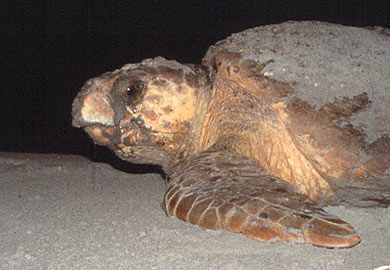DNR News
** Archived Article - please check for current information. **
May 5, 2015Loggerhead nest kicks off sea turtle season
Under a clear and chilly night sky this weekend, a female loggerhead sea turtle crawled ashore to ensure timely kick-off for nesting season.
The S.C. Department of Natural Resources (DNR) is excited to announce the first sea turtle nest of the year, laid on Botany Island the night of May 1.
The nest marks that beginning of what researchers expect will be a busy season. Because nesting exacts a high energy toll on the large reptiles, female sea turtles do not come ashore to lay eggs every year. This cyclical nesting pattern results in fewer sea turtle nests in some years than in others. In 2014, for instance, DNR biologists and volunteers counted 2,097 nests, down from 5,194 in 2013.
“This year, we’re looking forward to a higher nest count and a more active season than 2014,” said Michelle Pate, DNR biologist and coordinator for the agency’s Marine Turtle Conservation Program.
Volunteers from 30 different nest protection programs will spend the next several months patrolling South Carolina’s beaches each morning for crawls, the telltale tracks left by a sea turtle as it trundles ashore. Between bright lights, hazardous debris, and natural or man-made obstacles, beaches can be treacherous places for nesting females. Incubating eggs face additional threats, including erosive high tides and predators such as coyotes and raccoons.
Sea turtle clutches average 120 eggs and hatch after approximately 60 days. Nesting females may remain in South Carolina waters and continue to nest every two weeks, laying up to six nests per season. Throughout this stressful time, the turtles also abstain from eating.
Ongoing genetic analysis represents an exciting avenue of research in which DNR biologists continue to participate with a multi-state team led by Dr. Brian Shamblin of the University of Georgia. By collecting genetic samples from every nest identified in South Carolina, researchers can pinpoint the individual females that laid each nest – data that allows scientists to gauge the health of the overall nesting population and map family trees for the region’s sea turtles.
Four sea turtle species nest on South Carolina beaches: loggerheads, greens, Kemp’s ridleys, and leatherbacks. Loggerhead nests comprise the vast majority of the state’s total number each year. All four sea turtle species are classified as endangered or threatened and are protected under the Endangered Species Act in addition to local and state ordinances.
Individuals that violate federal law by harming or interfering with sea turtles or their nests can be subject to civil penalties of up to $25,000 and up to a year’s imprisonment.
South Carolina beachgoers can help the state’s sea turtles by keeping beaches free of holes, trash, and obstructions, turning beachfront lights out (or closing window blinds) to avoid disorienting turtles, and giving all sea turtles and nests a wide and respectful berth when encountered on the beach.
Sea Turtle Season Reminders
* Keep Lights Out! on beachfront property during nesting season.
* Refrain from using flash photography on the beach at night.
* Keep our beaches and ocean clean. Trash items such as plastic bags and balloons can cause injury or death when sea turtles mistake them for jellyfish, a favorite food.
* Respect sea turtles by observing them from a distance on the beach.
* Report dead or injured sea turtles and nest disturbances to SCDNR at 1-800-922-5431.
* Report sightings of live, healthy turtles to DNR
* Promote and support our program for continued conservation of sea turtles in South Carolina.
More News
- Statewide deer harvest decreases in 2014
- DNR offers guidelines for dealing with bears; report a sighting on website
- Piedmont Forestry Center youth fishing rodeo set May 16 in Oconee County
- Loggerhead nest kicks off sea turtle season
- DNR hosts inaugural Youth Sporting Clay Open
- 2015 public alligator hunting, special WMA season applications available online
- Laws are strict on taking wild turkey eggs and releasing pen-raised turkeys
- DNR continues access improvements at Woodbury WMA
- Learn and Burn workshop lets landowners see prescribed fire benefits up close
- DNR continues habitat improvement at Marsh WMA
- Get on course with DNR's new Boating Virtual Trainer
- Aiken County wildlife area opens to the public Saturdays in May
- DNR hosts series of youth fishing rodeos/family fishing clinics around the state
- Freshwater fishing trends
- Saltwater fishing trends
- S.C. weekly tidetable
- DNR video
- Archived news releases
